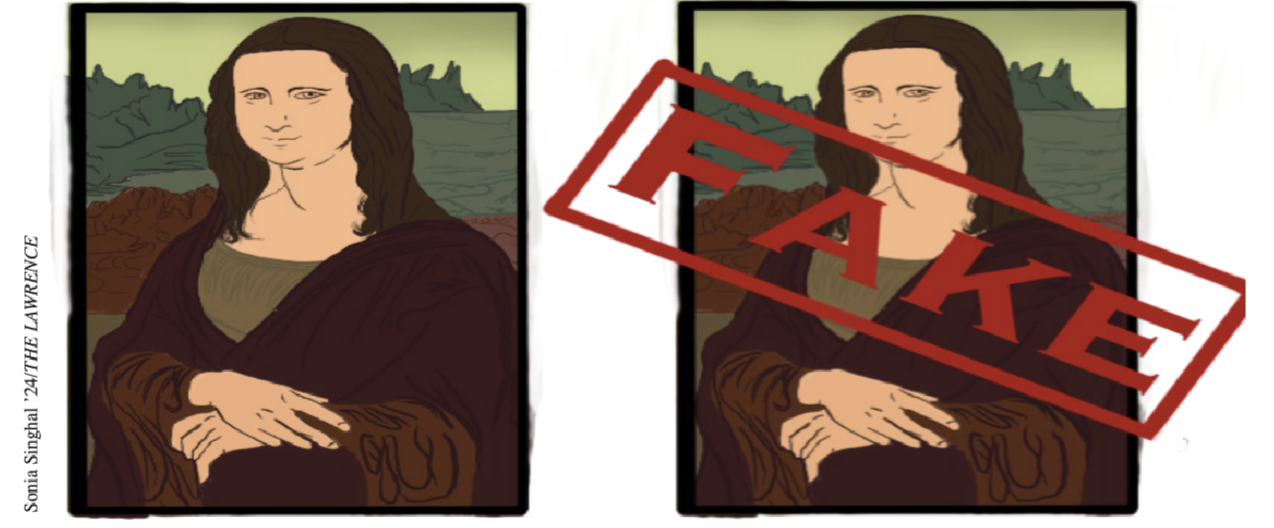Thursday, April 24
You’re so Fake: An Exploration of Art Replicas
Sophie Yang '26 in Arts | December 8, 2023

What is real art, and what is fake? Does this difference really matter? Is there truly a difference to begin with? In this modern epoch of visual art, the question of authenticity has relentlessly wedged itself into our perception of art, unfortunately straying from the simple, humble form of visual entertainment art has always been. Now, especially with the rise of A.I. art, our criteria for judging art have changed from simply appreciating its visual aesthetic to the initial questioning of whether the art piece was A.I. generated or not. Like mindless drones scrolling away in the endless onslaught of braindead content known as social media, self-proclaimed critics tap fiercely away at their blue phone screens, unapologetically criticizing strangers for drawing the wrong facial proportions and then accusing others of fraud when their art is “too good” to be real. Art forums transform into warzones—contemporary art is ridiculed, A.I. users are publicly shamed, traditional artists look down on digital artists, and artists draw solely for likes and follows.
Recently, a German man stole four paintings from the Deutsches Museum in Munich and replaced them with replicas. Together, the paintings were worth hundreds of thousands of dollars, and the man decided to auction them off to fund his shortlived luxury lifestyle. The museum soon realized that fakes had replaced their collection of paintings, and the man was arrested and fined. While all the paintings were safely returned to the Deutsches Museum and the case was closed, this story gave way to the moral dilemma surrounding replicas and whether they are legitimate works of art too. If someone made a perfect replica of the Mona Lisa and secretly replaced it with the real one, most ordinary viewers would never notice that it was not the original. And until an art critic comes out and reveals the truth, everybody would go about their day believing that it was the real thing. But then, the world would be shaken into an outrage that somebody dared to create a fake of the Mona Lisa and condemn the replicator as a liar and a fraud. Even if the artist made the same exact paint strokes as Leonardo Da Vinci, the simple fact that Da Vinci’s own hands didn’t draw it changes its worth from priceless to nothing. But, at the end of the day, the Mona Lisa is just another portrait of a woman, and since art is judged by visual aesthetics, shouldn’t the replica and the original be worth the same amount?
Recently, a German man stole four paintings from the Deutsches Museum in Munich and replaced them with replicas. Together, the paintings were worth hundreds of thousands of dollars, and the man decided to auction them off to fund his shortlived luxury lifestyle. The museum soon realized that fakes had replaced their collection of paintings, and the man was arrested and fined. While all the paintings were safely returned to the Deutsches Museum and the case was closed, this story gave way to the moral dilemma surrounding replicas and whether they are legitimate works of art too. If someone made a perfect replica of the Mona Lisa and secretly replaced it with the real one, most ordinary viewers would never notice that it was not the original. And until an art critic comes out and reveals the truth, everybody would go about their day believing that it was the real thing. But then, the world would be shaken into an outrage that somebody dared to create a fake of the Mona Lisa and condemn the replicator as a liar and a fraud. Even if the artist made the same exact paint strokes as Leonardo Da Vinci, the simple fact that Da Vinci’s own hands didn’t draw it changes its worth from priceless to nothing. But, at the end of the day, the Mona Lisa is just another portrait of a woman, and since art is judged by visual aesthetics, shouldn’t the replica and the original be worth the same amount?
My answer to this is that the modern criteria for judging art assigns different values to artwork based on their age. Nowadays, there is an urgency to protect and preserve as much of the past as we can. As such, we view relics of the past as limited-edition collectibles. No matter how similar a replica may be, it will never carry the same history, memories, creativity, or arduous process of trying over and over again as the original. The same logic applies to A.I. art, which will never have the heart and thought put into it as something created by a human. Art, in this modern day and age, goes far beyond a piece of visual entertainment. As the zeitgeist of an era changed, art, too, like a butterfly undergoing metamorphosis, will continue to evolve, creating new definitions for itself. Perhaps contemporary art will slowly find its roots again in old Renaissance masters, or perhaps it’ll continue to embrace the abstract and futuristic, but it’s the history behind a single drawing, a single painting, a sing.
Related Articles
- Mirror, Mirror, on the Wall... Who’s the Most Hated of Them all? Melina Kyriakopoulos ’27
- L Factor or L moment? Lawrentians Take the Stage Celestine Sutter ’27
- Spring Orchestra Concert Vincent Jie ’27
- Shedding Light on Julius Caesar Anton Popowitz ’26
- Threaded Up Thursdays: Intertwining Soul and Style Melina Kyriakopoulos ’27
Recent Articles
- Announcing: Valedictorian, Aurelian Speakers, and Faculty Speaker Sophie Liu ’27
- Senior Profile: Sophie Cheng ’25 Katherine Qiu ’27
- Debunking the Dining Hall Debate: Is Lawrenceville’s Dining Really That Bad? Isabelle Lee ’27
- Welcoming Our New VPs for 2025-2026 Sophie Liu ’27
- A Sweet Return: Melba Reopens with New Flavors and Community Spirit Ella Song ’27